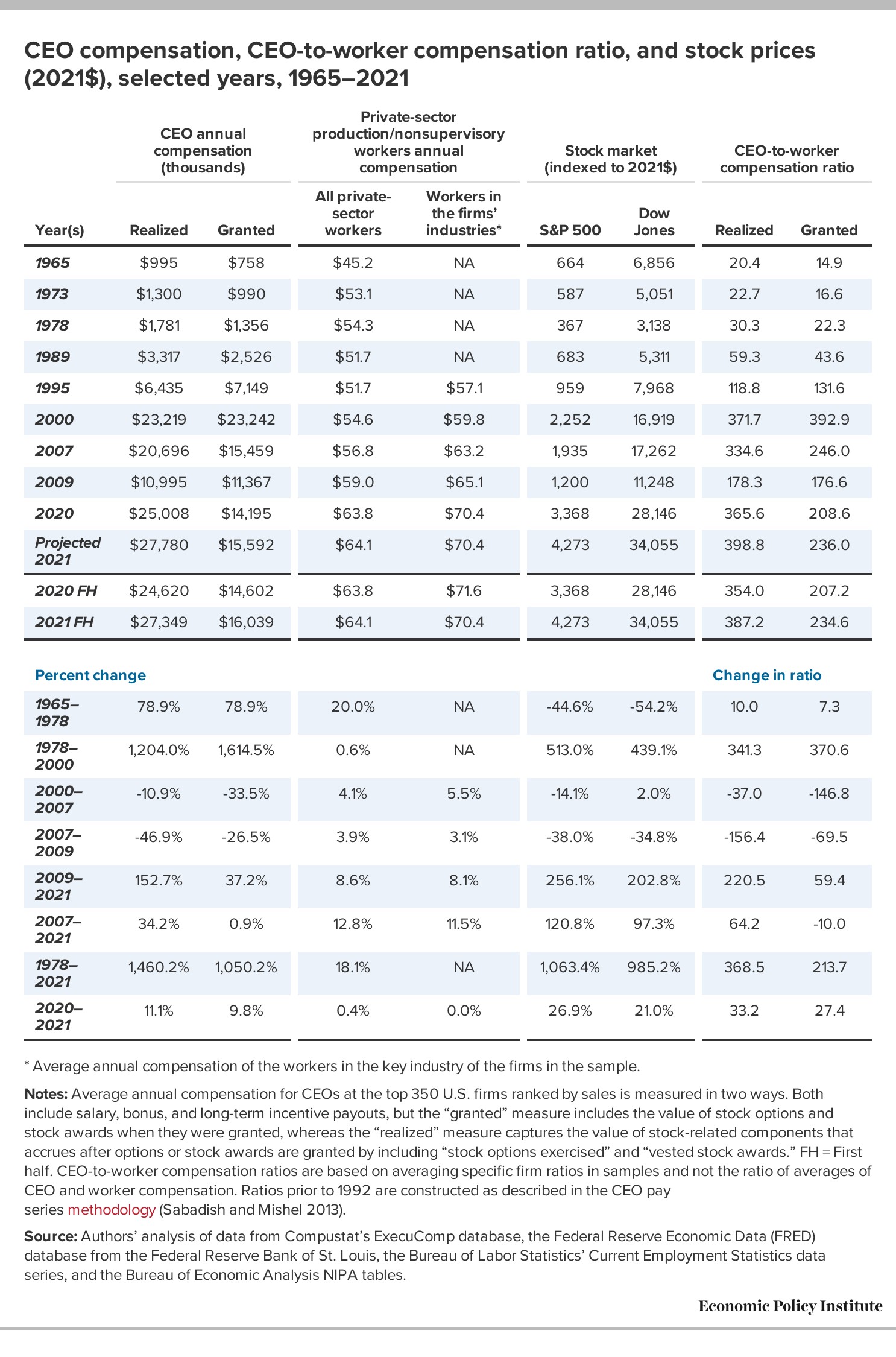Are Ceos Paid Too Much Compared To Their Employees? It’s a question that sparks debate and raises concerns about income inequality. COMPARE.EDU.VN delves into this complex issue, offering insights and data-driven analysis to help you form your own informed opinion on executive compensation relative to worker wages and whether CEO earnings are justified. We aim to address this concern and provide resources to compare executive salary packages and market dynamics.
1. Understanding CEO Compensation Trends
CEO compensation has exploded in recent decades. Using realized compensation measures, the compensation of top CEOs increased 1,460.2% from 1978 to 2021, after adjusting for inflation. It substantially exceeded both the stock market growth rate (1,063%) and the typical worker’s annual compensation growth (18.1%) during this period. Analyzing these statistics, it becomes clear that the surge in executive remuneration is independent of productivity metrics.
1.1. The Pandemic Impact on CEO Pay
The COVID-19 pandemic further widened the gap. From 2019 to 2021, CEO compensation jumped 30.3%, while typical worker compensation increased by a mere 3.9%. Such contrasting figures highlight the disparity between executive pay and average employee income even in times of widespread economic uncertainty.
1.2. CEO-to-Worker Compensation Ratio Over Time
The ratio of CEO-to-worker compensation reached a staggering 399-to-1 in 2021. Back in 1965, it was only 20-to-1. This exponential growth clearly shows that CEO pay is growing much faster than that of the average worker, underscoring questions about fair compensation practices.
2. The Composition of CEO Compensation Packages
A significant portion of CEO compensation comes from stock-related components. By 2021, these components made up 82.0% of total CEO compensation, with vested stock awards accounting for a growing share. There is a shift from stock options to stock awards to better align the CEO’s interests with those of the shareholders.
2.1. The Impact of Stock Awards vs. Stock Options
Companies are increasingly opting for stock awards over stock options because of their impact on risk management. Stock options may incentivize CEOs to take excessive risks to inflate short-term stock prices. Stock awards, however, encourage longer-term planning and stability, better aligning the CEO’s goals with shareholder value.
3. Measuring CEO Compensation: Realized vs. Granted
There are two common measures of CEO compensation: realized and granted. The “realized” measure includes the value of stock options when exercised, capturing the changes from when the options were granted. The “granted” measure, on the other hand, values stock options at their fair value when granted. Both measures consider salary, bonuses, and long-term incentive payouts.
3.1. Why the Difference Matters
The “realized” measure gives a clear picture of what CEOs actually earn, reflecting the performance of the company over time. The “granted” measure provides an initial estimate of compensation, which may not accurately represent the final earnings. This distinction is critical when comparing CEO pay across different companies and time periods.
4. Examining Historical Trends in CEO Compensation
Over the decades, CEO compensation has generally tracked the stock market. However, from 1965 to 1978, CEO compensation increased significantly even as the stock market fell. From 1978 to 2000, realized CEO compensation grew by 1,204%, dwarfing the 0.6% growth in typical worker compensation. These trends underscore the debate on whether executives are fairly rewarded for their role in their organization.
4.1. CEO Pay vs. Typical Worker Pay
The dramatic divergence between CEO pay and typical worker pay highlights the increasing disparity in income distribution. While CEOs enjoy substantial compensation packages, many workers struggle with stagnant wages, increasing economic inequality. These factors drive the ongoing dialogue about how CEOs should be paid compared to their employees.
5. The Argument Against Market-Driven Compensation
One popular explanation for high CEO pay is that it’s simply a reflection of the market for skills and talent. However, data suggests that CEO compensation has grown far faster than that of other very highly paid workers, undermining this argument. It’s crucial to consider the influence of non-market factors on executive remuneration.
5.1. CEO Pay Compared to the Top 0.1% of Earners
CEO compensation has significantly outpaced the earnings of the top 0.1% of wage earners. In 2020, CEO pay was 6.88 times the pay of the top 0.1%, a ratio substantially higher than in previous decades. The wage data raises questions as to whether the “market for talent” is the sole driver.
5.2. Comparing Returns to Education
The rise in CEO pay has also far exceeded the rise in the college-to-high-school wage premium. This further challenges the notion that high CEO pay is simply a result of increasing returns to education and skills. Instead, it suggests that other factors are at play, like market influence.
6. Debunking the Myth of Performance-Based Pay
While it’s often claimed that CEOs are paid for their performance, the connection between stock prices and CEO compensation does not necessarily imply a direct link to individual productivity. CEO compensation often rises with the overall stock market, regardless of whether the firm’s performance is exceptional. It is crucial to distinguish between general market trends and individual contributions when evaluating executive pay.
6.1. The Role of Luck vs. Skill
Rising stock prices can be driven by various factors, including overall market trends and reduced corporate taxes. It raises questions about whether CEOs are being rewarded for their skills or simply benefiting from favorable economic conditions. Therefore, when CEOs earn more, there should be a question of skill versus luck.
7. The Connection Between CEO Pay and Overall Inequality
Exorbitant CEO compensation is not merely a symbolic issue. It contributes to the growth of top 1% and top 0.1% incomes, which increases overall inequality. The data suggest that rising executive pay exacerbates income disparities, leaving fewer gains for ordinary workers.
7.1. Impact on Wage Growth for the Bottom 90%
Rising executive pay impacts wage growth for the bottom 90%. Most of the increase in inequality has taken the form of redistributing wages from the bottom 90% to the top 1%, affecting broad-based wage growth.
8. Policy Recommendations for Reversing the Trend
Several policy options could reverse the trend of excessive executive pay and promote broader wage growth. These include higher marginal income tax rates for top earners, increased corporate tax rates for firms with high CEO-to-worker compensation ratios, and changes in corporate governance to give shareholders more say on executive pay.
8.1. Tax Policies to Limit Rent-Seeking Behavior
Implementing higher marginal income tax rates at the very top would limit rent-seeking behavior and reduce the incentives for executives to push for high pay. Another option involves setting corporate tax rates higher for firms with high CEO-to-worker compensation ratios.
8.2. Corporate Governance Reforms
Reforms such as greater use of “say on pay” can provide shareholders with more influence over executive compensation. Changes to corporate governance, including worker representation on corporate boards, can also help restrain excess pay.
9. How to Make Informed Decisions on Executive Compensation
Understanding the debate on executive compensation and worker pay is vital for making informed financial decisions. Accessing the right resources allows individuals and organizations to compare compensation packages, analyze market trends, and assess corporate governance practices. This knowledge is the foundation for equitable compensation practices and a fair economic landscape.
9.1. Accessing Reliable Comparison Tools
COMPARE.EDU.VN provides extensive tools for comparing compensation packages across various sectors. By using these resources, individuals can analyze whether CEO compensation aligns with industry standards, corporate performance, and employee welfare. Our database helps to highlight companies that are not being equitable in their salary packages.
9.2. Analyzing Corporate Governance Practices
It is crucial to assess corporate governance practices. Transparent corporate governance and equitable CEO-to-worker pay ratios are essential for long-term financial health. COMPARE.EDU.VN helps to evaluate these aspects, ensuring investments are made in ethically managed and financially sound companies.
10. Key Considerations and Insights
The debate around CEO compensation and worker pay touches on broader socioeconomic issues, including income inequality and ethical business practices. By critically assessing these factors, individuals can make financial decisions that promote both personal success and societal well-being.
10.1. Ethical Implications of Pay Disparities
The widening gap between CEO pay and worker pay raises ethical concerns. Organizations that address these disparities can foster greater employee morale, consumer trust, and overall sustainability. This results in a more balanced and fair society.
10.2. Promoting Economic Fairness and Sustainability
Focusing on economic fairness and sustainability can drive systemic change. Policy reforms, corporate responsibility, and individual awareness collectively contribute to a more equitable economic landscape, which promotes prosperity and long-term growth for all.
11. Summary
Ultimately, the question of whether CEOs are paid too much compared to their employees is multifaceted, with no easy answers. However, by understanding the trends, data, and policy implications, we can engage in a more informed discussion and work towards a more equitable and sustainable future. CEO-to-employee compensation is constantly increasing, and that trend needs to come to a stop.
12. Call to Action
Make informed decisions with COMPARE.EDU.VN. Explore our comparison tools and resources to gain insights into CEO compensation and worker pay. Take control of your financial future and contribute to a more equitable world. Visit COMPARE.EDU.VN today for detailed comparisons and resources to guide your decisions!
Are you struggling to make sense of the complex world of executive compensation? Do you want to ensure that your financial decisions align with your values? Visit COMPARE.EDU.VN today to access our comprehensive comparison tools and resources.
Our platform offers:
- Detailed comparisons of CEO compensation packages across various industries.
- Analysis of corporate governance practices and CEO-to-worker pay ratios.
- Insights into the ethical implications of pay disparities and their impact on economic inequality.
Empower yourself with the knowledge you need to make informed choices and contribute to a more equitable and sustainable future.
Visit COMPARE.EDU.VN now and start your journey towards financial empowerment and social responsibility.
Contact Us:
- Address: 333 Comparison Plaza, Choice City, CA 90210, United States
- WhatsApp: +1 (626) 555-9090
- Website: COMPARE.EDU.VN
13. Frequently Asked Questions (FAQs)
1. Why is CEO compensation so high compared to employee wages?
CEO compensation has grown due to stock-related components and managerial power, often outpacing typical worker pay and productivity.
2. What is the CEO-to-worker compensation ratio?
The CEO-to-worker compensation ratio measures the difference between CEO pay and typical worker compensation, reaching 399-to-1 in 2021.
3. How has CEO compensation changed during the pandemic?
CEO compensation jumped 30.3% between 2019 and 2021, while typical worker compensation increased by only 3.9%.
4. What are the key components of CEO compensation packages?
Key components include salary, bonuses, long-term incentive payouts, stock options, and stock awards.
5. How do stock awards differ from stock options in CEO compensation?
Stock awards promote better alignment with shareholder goals by encouraging long-term performance, while stock options can incentivize short-term gains and excessive risk-taking.
6. What is the difference between realized and granted CEO compensation measures?
The realized measure includes the value of stock options when exercised, while the granted measure values stock options at their fair value when granted.
7. How can corporate governance reforms help control executive pay?
Corporate governance reforms like “say on pay” give shareholders more influence over executive compensation, promoting accountability.
8. What role do ethical considerations play in assessing CEO compensation?
Ethical considerations focus on the fairness and sustainability of pay disparities, encouraging greater employee morale and trust.
9. How does COMPARE.EDU.VN help in making informed decisions about executive compensation?
compare.edu.vn provides tools for comparing compensation packages, analyzing corporate governance, and understanding the economic impacts of pay disparities.
10. What policy changes can reduce excessive executive pay?
Policy changes include higher marginal income tax rates for top earners and increased corporate tax rates for firms with high CEO-to-worker compensation ratios.

